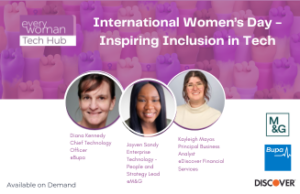When pundits were compiling ‘top tech trends to watch’ lists at the beginning of 2020, they had no clue as to the handbrake turn the year would take in March. While some didn’t materialise in quite the roaring way predicted (self-driving cars…), others took on new resonance as the year — and the Covid-19 pandemic — wore on. And with so many accelerations in innovation, including women in the conversation was more crucial than ever. We look at five of the biggest tech trends to come out of this year — and how women are playing a big part in driving them.
Women’s natural skills are key to realising AI’s potential
The acceleration of robotic technology and AI continues to dominate the tech space, but despite this, experts are increasingly emphasising the importance of soft skills in the workplace of the future. Far from AI making jobs in tech obsolete, as many feared, it may in fact actually create a premium on unique human input such as creativity and emotional intelligence.
A 2020 LinkedIn survey showed that the majority of business leaders believe that AI and human soft skills will both drive leadership priorities in the future, with an ability to embrace technology in second place. Bernard Marr, author of Artificial Intelligence in Practice, calls this new era in business the ‘Intelligence Revolution’, noting, ‘In the future we will have to work alongside machines and AI, which means we need to possess the skills that those machines haven’t got.’
Creativity, emotional intelligence and the ability to inspire and help others to achieve are all skills which are intrinsically human. And importantly, they belong to a skillset in which women excel, as many studies have shown. Recent research by the Korn Ferry Hay Group, for example, analysed data from 55,000 professionals across 90 countries, revealing higher scores for women on nearly all emotional intelligence competencies. Only emotional self-control was equally weighted between men and women. As such, women can have a unique and powerful impact on how AI is integrated into and used in the world — and may indeed hold the key to unlocking its potential.
Work-life for women…hangs in the balance
Working from home was a major theme of 2020, made possible by legacy technology and accelerated innovation to meet the needs of workforces deposed from the office. For women, this shift was a mixed blessing. On the plus side the lack of commute and increased flexibility undoubtedly benefits women, who still do the bulk of the childcare (a pre-pandemic government report1 found that almost a third of women in the UK with a child under 14 had needed to cut their working hours because of childcare issues — for men that figure was just one in ten). But some research has pointed to the fact that women’s domestic burden actually increased during the pandemic. A study carried out by Boston Consulting Group found mothers in the UK did an additional 31 hours’ housework each week during lockdown — and 12 more hours of household chores than fathers did.
With changes in cultural expectations and a more equal distribution of labour between men and women in this area, the potentials of home or hybrid working, now being adopted by many companies as a ‘new normal’, could have profound knock-on impacts on women’s careers that will last far beyond this year.
Women lead the way in augmented reality
With restrictions on movement and meeting in-person for much of this year, the trend toward digitally extended realities, encompassing virtual reality (VR), augmented reality (AR) and mixed reality (MR), took on new resonance. Having started in the gaming space, altered realities is now expanding into areas such as on/offline networking, brand customer experience, improved visualisation of data and communications (the latter ignited in 2018 with the launch of the world’s first holographic press release by AR/VR pioneer Cathy Hackl).
VR in particular has been gathering momentum for a number of years now and has entered mainstream use largely due to the affordability of the Oculus headsets. As a young technology, it has been relatively open to women from the outset — a 2017 survey of 70 international VR and AR companies revealed that 64.3 per cent were led by women. Industry experts have put this relative lack of gender bias compared to traditional gaming down to it being one of the first industries to be created in a time of gender equality awareness and noting that because it requires talent from all entertainment and technologies, women have naturally gravitated toward it.
In technical roles too, female engineers are flourishing — from Ana Garcia Puyol, AR/VR Product Design Lead at Oculus/Facebook whose work was integral to the launch of 2019’s next-generation Oculus Quest headset to Timoni West, XR Product Director at Unity Technologies, leading advanced product development for spatial computing tools in AR, VR and MR. What’s certain is that as we reimagine our lived experiences post-pandemic, this tech will continue to gain pace, and with women at the forefront of development.
Big tech commits to greater diversity
Increasing diversity in the workforce has been a virtue signal from big tech for many years now, but the sector has been slow to act. This year, though, change took on new impetus with a raft of public commitments from Facebook, Google and other tech companies on just how they intend to diversify their workforces.
Intel Corp was one of the first this year, announcing it was increasing the number of women in technical roles to 40% and doubling the number of women and underrepresented minorities in senior roles by 2030. Facebook COO Sheryl Sandberg followed, announcing that the company had committed to a 30% increase in people of colour in leadership positions over the next five years. Doubling down on the business case, she noted, ‘More diverse teams make better decisions and build better products. Over the next five years, we’re committing to have 30% more people of colour in leadership positions. We will also continue our efforts to increase the representation of women in leadership.’
Microsoft too will add $150m to its diversity and inclusion investments and double the number of African American senior leaders in the USA by 2025. ‘We need to ensure that our culture of inclusion is a top priority for everyone,’ said Chief Executive Satya Nadella. ‘Each of us must be able to thrive in diverse teams. Every manager must be able to attract, retain and grow employees of all backgrounds…It is the new baseline for manager excellence across industries across the globe.’
FemTech shows healthy growth
In a year where health topped the agenda, FemTech continued to be a force, with a growing number of internet of things (IoT) applications tackling women’s issues. The IoT in healthcare market is estimated to grow to $322bn by 2025, and the need for products designed by and for women continues to be pressing. Inherent bias toward the male body in medical data and the expression of that in tech products means that gender-blind product design processes are common. Products are often still made without women’s input — the most high-profile fail of recent times arguably the first Apple Health Kit, which tracked every bodily function apart from women’s periods.
‘First- and second-generation wearables were very generic or male-focused. I think at that point women saw an opportunity,’ says Marija Butkovic, founder of Women of Wearables, a global organisation championing women in tech. And thanks to smartphones we can now gather data about ourselves from health apps and take direct control of our wellbeing; from tracking hormone levels to monitoring pregnancy health, fertility or migraines to use of smart breast pumps and pelvic floor trainers. The opportunities for disruptive female-led tech development in the health space continues to grow and grow. However, women still lag behind men when it comes to funding. Recent data from PitchBook shows money raised by female-founded companies collapsed to 2017-levels in 2020, even with a market that shows all the vital signs of a robust constitution.



